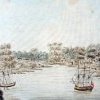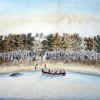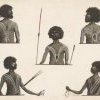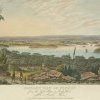1780s
1780
1788
Lieutenant Tench describes a ridge on the north west arm of Botany Bay with ‘more than a dozen houses and perhaps five times that number of people; being the most considerable establishment that we are acquainted within this country. The huts occupied by this clan of about sixty people live near the outlet’ (of the Cooks River). This area according to the historian Vincent Smith is the heartland of the Kameygal Spear Clan.
Lieutenant Bradley: ‘The Governor’s fishing boat met a great number of the natives in the lower part of the Harbour as they were hauling the Sein (fishing net). The people gave fish to all the natives, but they were not satisfied with that. They closed upon the people employed in the boat, and took what they pleased, their musquet happening to be left in the boat.’ One of the women made a fishing hook from the inside of what is commonly called the Pearl Oyster shell, by rubbing it down on the rocks until thin enough and then cut it circular with another, shaped the hook with a sharp point, rather bent in and not bearded or barbed''. (Cobley, pp. 98, 183)
Note: Distribution of named clans or bands in the Sydney region. (p. xxiii.)
Just over half the place names (60) were recorded initially by officers of the first fleet between 1788 and 1800. (Koch and Hercus, p. 13)
1789
Phillip orders another kidnapping on Manly beach. The prisoners are Coleby (the uncle of Nanbury, a captured Koori child) and Bennelong. (Banelong). Bennelong becomes well known to the colonists. The historian Vincent Smith writes that “a body of evidence places Bennelong as the leader of an Aboriginal clan observed on the north side of the Parramatta river, between Kissing Point and Parramatta in the early years of the 19th Century'. He becomes a favourite of Phillip. (Vincent Smith p. 24, Karskens, pp. 379-380)
A convict searching for a local herb known as ‘sweet tea’ in the Brickfields area is killed and his body mangled possibly by ‘Gomerigal’ (Camaraigal) or Cadigal people. Other brick-makers form a revenge party and march down what is today’s Oxford Street, armed with work tools and large clubs. They meet 50 Eora warriors who run away from them. The historian Karskens interprets the incident as the officer Collins realising that the attack was an attempt by the Cadigal at containment, trying to restrict the colonists to Sydney Cove. On the same day Phillip sends out two armed parties to march to Botany Bay and elsewhere. Collins writes ‘that the natives might see their late acts of violence would neither intimidate nor prevent us from moving beyond the settlement whenever occasion required.’ Karskens, pp. 356- 368.
Arabanoo is taken back down the harbour to look for his Cammeraigal family and friends. Collins writes, ‘He looked anxiously around him … Not a vestige on the sand was to be found of human foot … not a living person was anywhere to be met with. It seemed as if in flying from contagion they had left the dead to bury the dead (from small pox). He lifted up his hands and eyes in silent agony for some time: at last he exclaimed ‘All dead! All dead!’ and then hung his head in mournful silence.’ He himself dies, probably of smallpox, later the same year. Karskens, p. 373.
Describing the effects of smallpox, David Collins, Judge Advocate of the colony, writes that 'Kooris are seen lying on the ground, either in excavations of the rock, or lying upon the beaches and points of the different coves which they had been in, the bodies of many of the wretched natives of this country. The cause of this mortality remained unknown until a family was brought up, and the disorder pronounced to have been small pox.’












